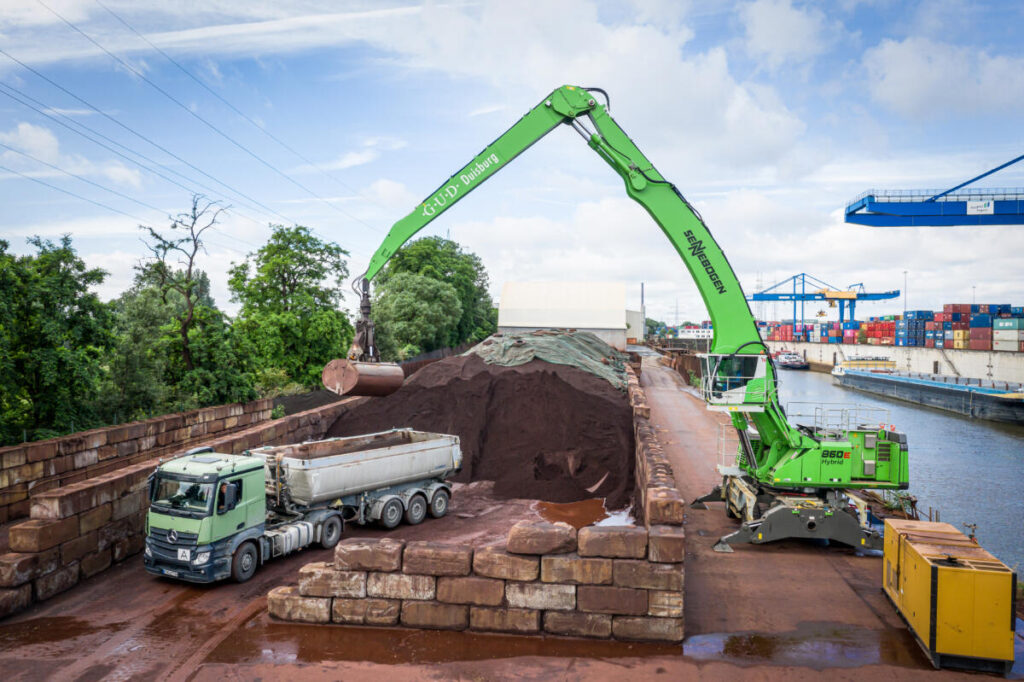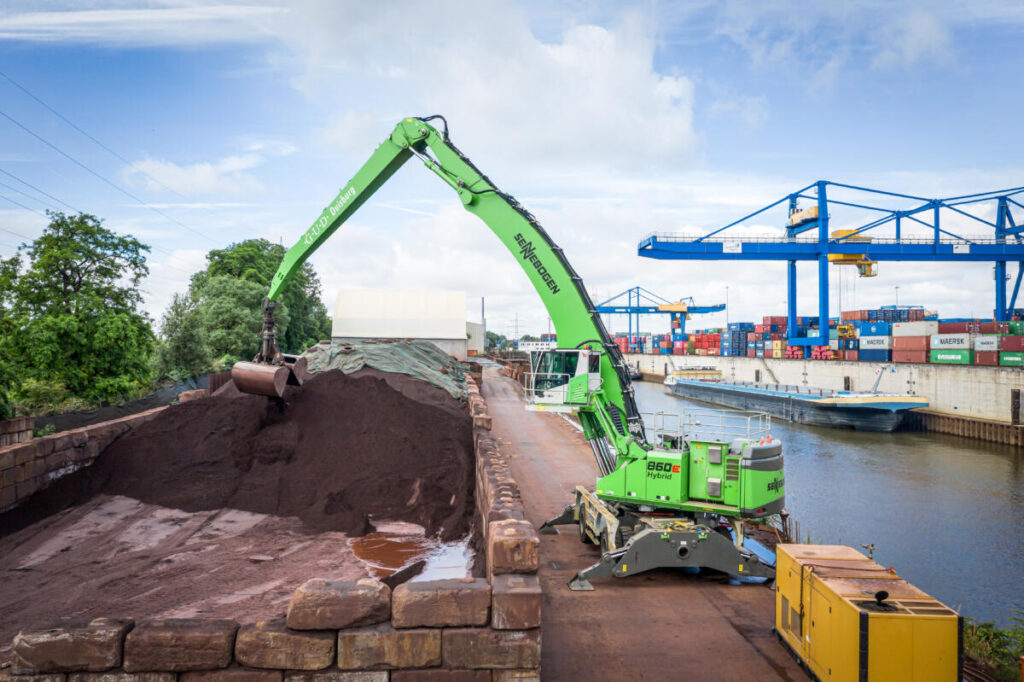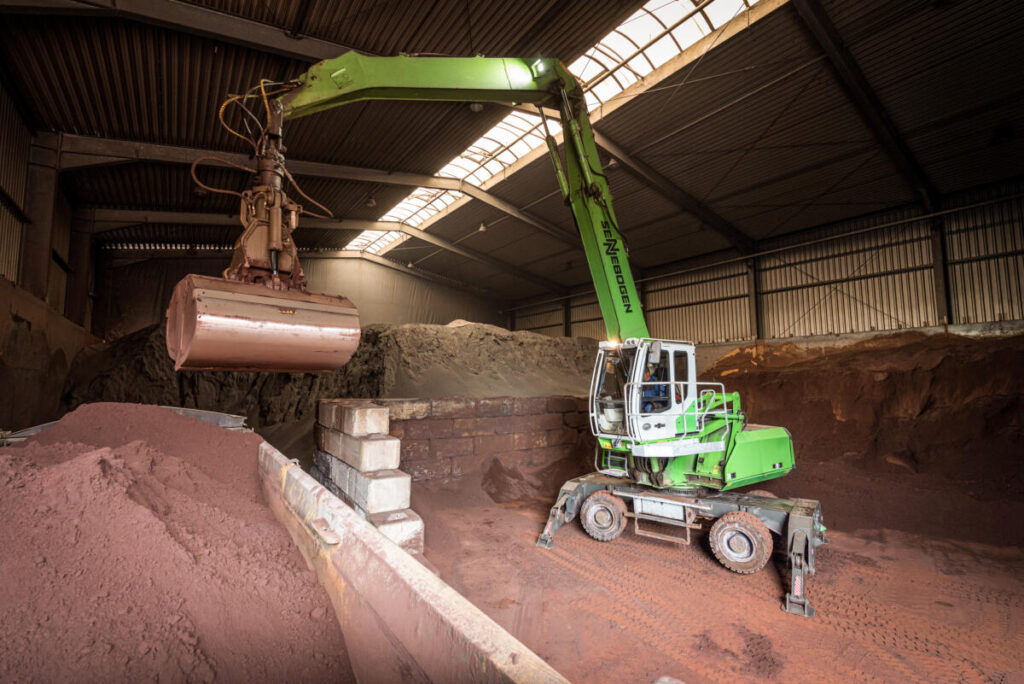
SENNEBOGEN 860 E Series hybrid: on a 2,600 ft. (800 m) dock, GUD in Duisburg, Germany relies on electric mobility in the port and uses a diesel generator for short travel distances to the next power supply.
Duisburg, Germany – Since 2002, Gesellschaft für Umweltdienste mbH (GUD) has been successfully managing its business in one of the most important inland ports in Europe. With 30 employees, the tasks of the company in the Port of Duisburg, Germany goes far beyond that of a traditional cargo handling company. With the acquisition of the new SENNEBOGENs in their fleet, they have also created a new revenue stream for their operation: renting out material handling machinery and fully trained personnel to maximize the machines’ capacity and availability.
In 2019 and 2020, the Duisburg-based company redesigned its 2,600 ft. (800 m) unloading dock. They now operate two SENNEBOGEN 860 E Hybrid electric material handlers with 340 HP (250 kW) engines. With a peak handling capacity of up to 800 t per hour, the company proves that electric material handlers are just as powerful as their diesel counterparts. In fact, the loading and unloading of ships with bulk materials is low-maintenance, effortless and at the same time, highly efficient and cost-effective.
Mobility in electric material handlers comes in many forms and offers the potential for significant savings. Andreas Frye, Managing Director of GUD in Duisburg, is now using two electrically powered SENNEBOGEN 860 E Hybrid material handlers on the redesigned dock. Everything has proven to be a huge success states Frye. “No oil changes, fewer components compared to the diesel version and less maintenance required. So, the calculation was simple for us: the 860 E electric material handler is always ready to go and, on top of that, it reduces our operating costs by 50%.”
With a total of seven electric SENNEBOGEN material handlers already onsite, GUD was already well-versed with its capabilities. However, there was still more to be discovered. One of the SENNEBOGENs was an older, electrically powered 870 C Series that had been running trouble-free for 12 years and had over 20,000 operating hours on the meter. Andreas realized that there was potential to update the operations by adding electrification directly on the dock. “A continuous, cable-connected power supply over 2,600 ft., the length of the dock, would be difficult to implement because of that distance; disconnecting from the power source would be unavoidable. The ideal solution for us was to place an additional connection point every 130-160 ft. (40-50 m). To get to the next power source, the 860 pulls a diesel generator, which allows the short distance to be mastered perfectly.”
Technology and service = Uptime
An 825 D Series from 2016 with just over 7,000 hours has been very reliable for GUD and it continues to perform its tasks reliably and quickly. Andreas Frye explains how important manageable technology and proximity to his business partners are to him. “We enjoy the excellent service from our dealer and the close relationship with SENNEBOGEN is also important to us. The machines always offer state-of-the-art technology and are not packed with unnecessary electronics: this also means that we can do some service work ourselves. As a result, we manage to keep machine uptime permanently high.”
New revenue streams
Cargo handling companies like GUD perform demanding work and need specialized machinery to cope with the variety of materials in ports. Every year, approximately 250 ships with a capacity of between 1,000 and 5,000 t dock here. In total, around 500,000 tons of material are moved each year, most of which is bulk cargo. Today, in addition to classic bulk handling, GUD also specializes in the rental business. Andreas Frye explains that “In order to make the best possible use of our machines, we provide some of our diesel powered SENNEBOGEN material handlers for use on construction/demolition sites or to other ports. Not only do we offer equipment but we provide skilled operators too. Their know-how is even more in demand than ever before; a clear unique selling point, especially during times of a skilled labor shortage.”


